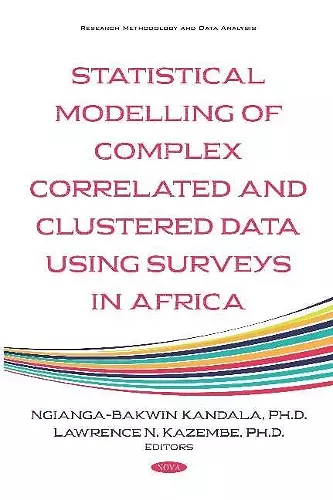Statistical Modelling of Complex Correlated and Clustered Data Household Surveys in Africa
Format:Hardback
Publisher:Nova Science Publishers Inc
Published:1st Oct '19
Currently unavailable, and unfortunately no date known when it will be back

In order to assist a hospital in managing its resources and patients, modelling the length of stay is highly important. Recent health scholarship and practice has largely remained empirical, dwelling on primary data. This is critically important, first, because health planners generally rely on data to establish trends and patterns of disease burden at national or regional level. Secondly, epidemiologists depend on data to investigate possible risk factors of the disease. Yet the use of routine or secondary data has, in recent years, proved increasingly significant in such endeavours. Various units within the health systems collected such data primarily as part of the process for surveillance, monitoring and evaluation. Such data is sometimes periodically supplemented by population-based sample survey datasets. Thirdly, coupled with statistical tools, public health professionals are able to analyze health data and breathe life into what may turn out to be meaningless data. The main focus of this book is to present and showcase advanced modelling of routine or secondary survey data. Studies demonstrate that statistical literacy and knowledge are needed to understand health research outputs. The advent of user-friendly statistical packages combined with computing power and widespread availability of public health data resulted in more reported epidemiological studies in literature. However, analysis of secondary data, has some unique challenges. These are most widely reported health literature, so far has failed to recognize resulting in inappropriate analysis, and erroneous conclusions. This book presents the application of advanced statistical techniques to real examples emanating from routine or secondary survey data. These are essentially datasets in which the two editors have been involved, demonstrating how to tackle these challenges. Some of these challenges are: the complex sampling design of the surveys, the hierarchical nature of the data, the dependence of data at the sampled cluster and missing data among many more challenges. Using data from the Health Management Information System (HMIS), and Demographic and Health Survey (DHS), we provide various approaches and techniques of dealing with data complexity, how to handle correlated or clustered data. Each chapter presents an example code, which can be used to analyze similar data in R, Stata or SPSS. To make the book more concise, we have provided the codes on the book's website. The book considers four main...
ISBN: 9781536159813
Dimensions: unknown
Weight: 800g
363 pages